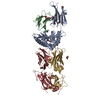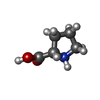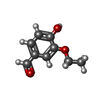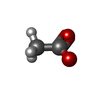[English] 日本語
 Yorodumi
Yorodumi- PDB-7ufj: Structure of human MR1-ethylvanillin in complex with human MAIT A... -
+ Open data
Open data
- Basic information
Basic information
| Entry | Database: PDB / ID: 7ufj | |||||||||
|---|---|---|---|---|---|---|---|---|---|---|
| Title | Structure of human MR1-ethylvanillin in complex with human MAIT A-F7 TCR | |||||||||
 Components Components |
| |||||||||
 Keywords Keywords | IMMUNE SYSTEM / ANTIGEN PRESENTATION / T-CELL RECEPTOR / MR1 | |||||||||
| Function / homology |  Function and homology information Function and homology informationpositive regulation of T cell mediated cytotoxicity directed against tumor cell target / antigen processing and presentation of exogenous antigen / MHC class I receptor activity / antigen processing and presentation of peptide antigen via MHC class I / beta-2-microglobulin binding / T cell receptor binding / positive regulation of ferrous iron binding / positive regulation of transferrin receptor binding / positive regulation of receptor binding / early endosome lumen ...positive regulation of T cell mediated cytotoxicity directed against tumor cell target / antigen processing and presentation of exogenous antigen / MHC class I receptor activity / antigen processing and presentation of peptide antigen via MHC class I / beta-2-microglobulin binding / T cell receptor binding / positive regulation of ferrous iron binding / positive regulation of transferrin receptor binding / positive regulation of receptor binding / early endosome lumen / Nef mediated downregulation of MHC class I complex cell surface expression / negative regulation of receptor binding / DAP12 interactions / cellular response to iron ion / Endosomal/Vacuolar pathway / Antigen Presentation: Folding, assembly and peptide loading of class I MHC / cellular response to iron(III) ion / antigen processing and presentation of exogenous protein antigen via MHC class Ib, TAP-dependent / negative regulation of forebrain neuron differentiation / regulation of erythrocyte differentiation / peptide antigen assembly with MHC class I protein complex / ER to Golgi transport vesicle membrane / regulation of iron ion transport / response to molecule of bacterial origin / MHC class I peptide loading complex / HFE-transferrin receptor complex / T cell mediated cytotoxicity / positive regulation of T cell cytokine production / antigen processing and presentation of endogenous peptide antigen via MHC class I / MHC class I protein complex / negative regulation of neurogenesis / positive regulation of receptor-mediated endocytosis / peptide antigen assembly with MHC class II protein complex / multicellular organismal-level iron ion homeostasis / MHC class II protein complex / cellular response to nicotine / specific granule lumen / positive regulation of cellular senescence / positive regulation of T cell mediated cytotoxicity / recycling endosome membrane / phagocytic vesicle membrane / peptide antigen binding / antigen processing and presentation of exogenous peptide antigen via MHC class II / negative regulation of epithelial cell proliferation / Immunoregulatory interactions between a Lymphoid and a non-Lymphoid cell / positive regulation of immune response / Interferon gamma signaling / Modulation by Mtb of host immune system / positive regulation of T cell activation / sensory perception of smell / negative regulation of neuron projection development / positive regulation of protein binding / tertiary granule lumen / DAP12 signaling / MHC class II protein complex binding / late endosome membrane / iron ion transport / ER-Phagosome pathway / T cell differentiation in thymus / early endosome membrane / protein refolding / defense response to Gram-negative bacterium / protein homotetramerization / intracellular iron ion homeostasis / amyloid fibril formation / learning or memory / defense response to Gram-positive bacterium / immune response / Amyloid fiber formation / endoplasmic reticulum lumen / lysosomal membrane / Golgi membrane / external side of plasma membrane / innate immune response / focal adhesion / Neutrophil degranulation / endoplasmic reticulum membrane / SARS-CoV-2 activates/modulates innate and adaptive immune responses / structural molecule activity / Golgi apparatus / endoplasmic reticulum / protein homodimerization activity / extracellular space / extracellular exosome / extracellular region / identical protein binding / membrane / plasma membrane / cytosol Similarity search - Function | |||||||||
| Biological species |  Homo sapiens (human) Homo sapiens (human) | |||||||||
| Method |  X-RAY DIFFRACTION / X-RAY DIFFRACTION /  SYNCHROTRON / SYNCHROTRON /  MOLECULAR REPLACEMENT / Resolution: 2.5 Å MOLECULAR REPLACEMENT / Resolution: 2.5 Å | |||||||||
 Authors Authors | Wang, C.J. / Rossjohn, J. / Le Nours, J. | |||||||||
| Funding support |  Australia, 2items Australia, 2items
| |||||||||
 Citation Citation |  Journal: J.Biol.Chem. / Year: 2022 Journal: J.Biol.Chem. / Year: 2022Title: Quantitative affinity measurement of small molecule ligand binding to Major Histocompatibility Complex class-I related protein 1 MR1. Authors: Wang, C.J.H. / Awad, W. / Liu, L. / Mak, J.Y.W. / Veerapen, N. / Illing, P.T. / Purcell, A.W. / Eckle, S.B.G. / McCluskey, J. / Besra, G.S. / Fairlie, D.P. / Rossjohn, J. / Le Nours, J. | |||||||||
| History |
|
- Structure visualization
Structure visualization
| Structure viewer | Molecule:  Molmil Molmil Jmol/JSmol Jmol/JSmol |
|---|
- Downloads & links
Downloads & links
- Download
Download
| PDBx/mmCIF format |  7ufj.cif.gz 7ufj.cif.gz | 343.9 KB | Display |  PDBx/mmCIF format PDBx/mmCIF format |
|---|---|---|---|---|
| PDB format |  pdb7ufj.ent.gz pdb7ufj.ent.gz | 270.4 KB | Display |  PDB format PDB format |
| PDBx/mmJSON format |  7ufj.json.gz 7ufj.json.gz | Tree view |  PDBx/mmJSON format PDBx/mmJSON format | |
| Others |  Other downloads Other downloads |
-Validation report
| Summary document |  7ufj_validation.pdf.gz 7ufj_validation.pdf.gz | 1.1 MB | Display |  wwPDB validaton report wwPDB validaton report |
|---|---|---|---|---|
| Full document |  7ufj_full_validation.pdf.gz 7ufj_full_validation.pdf.gz | 1.1 MB | Display | |
| Data in XML |  7ufj_validation.xml.gz 7ufj_validation.xml.gz | 59.9 KB | Display | |
| Data in CIF |  7ufj_validation.cif.gz 7ufj_validation.cif.gz | 83.8 KB | Display | |
| Arichive directory |  https://data.pdbj.org/pub/pdb/validation_reports/uf/7ufj https://data.pdbj.org/pub/pdb/validation_reports/uf/7ufj ftp://data.pdbj.org/pub/pdb/validation_reports/uf/7ufj ftp://data.pdbj.org/pub/pdb/validation_reports/uf/7ufj | HTTPS FTP |
-Related structure data
| Related structure data |  5u2vS S: Starting model for refinement |
|---|---|
| Similar structure data | Similarity search - Function & homology  F&H Search F&H Search |
- Links
Links
- Assembly
Assembly
| Deposited unit | 
| ||||||||||||
|---|---|---|---|---|---|---|---|---|---|---|---|---|---|
| 1 | 
| ||||||||||||
| 2 | 
| ||||||||||||
| Unit cell |
|
- Components
Components
-Protein , 2 types, 4 molecules ACBD
| #1: Protein | Mass: 31711.670 Da / Num. of mol.: 2 Source method: isolated from a genetically manipulated source Source: (gene. exp.)  Homo sapiens (human) / Gene: MR1 / Production host: Homo sapiens (human) / Gene: MR1 / Production host:  #2: Protein | Mass: 11879.356 Da / Num. of mol.: 2 / Fragment: UNP residues 21-119 Source method: isolated from a genetically manipulated source Source: (gene. exp.)  Homo sapiens (human) / Gene: B2M, CDABP0092, HDCMA22P / Production host: Homo sapiens (human) / Gene: B2M, CDABP0092, HDCMA22P / Production host:  |
|---|
-MAIT T-cell receptor ... , 2 types, 4 molecules GEHF
| #3: Protein | Mass: 22650.072 Da / Num. of mol.: 2 Source method: isolated from a genetically manipulated source Source: (gene. exp.)  Homo sapiens (human) / Production host: Homo sapiens (human) / Production host:  #4: Protein | Mass: 27546.562 Da / Num. of mol.: 2 Source method: isolated from a genetically manipulated source Source: (gene. exp.)  Homo sapiens (human) / Production host: Homo sapiens (human) / Production host:  |
|---|
-Non-polymers , 5 types, 400 molecules 








| #5: Chemical | | #6: Chemical | #7: Chemical | ChemComp-GOL / #8: Chemical | ChemComp-ACT / #9: Water | ChemComp-HOH / | |
|---|
-Details
| Has ligand of interest | Y |
|---|
-Experimental details
-Experiment
| Experiment | Method:  X-RAY DIFFRACTION / Number of used crystals: 1 X-RAY DIFFRACTION / Number of used crystals: 1 |
|---|
- Sample preparation
Sample preparation
| Crystal | Density Matthews: 2.87 Å3/Da / Density % sol: 57.2 % |
|---|---|
| Crystal grow | Temperature: 298 K / Method: vapor diffusion, hanging drop / Details: BTP PEG 3350 NaAc / PH range: 6.1 - 6.5 |
-Data collection
| Diffraction | Mean temperature: 100 K / Serial crystal experiment: N |
|---|---|
| Diffraction source | Source:  SYNCHROTRON / Site: SYNCHROTRON / Site:  Australian Synchrotron Australian Synchrotron  / Beamline: MX2 / Wavelength: 0.954 Å / Beamline: MX2 / Wavelength: 0.954 Å |
| Detector | Type: ADSC QUANTUM 315r / Detector: CCD / Date: Feb 20, 2021 |
| Radiation | Protocol: SINGLE WAVELENGTH / Monochromatic (M) / Laue (L): M / Scattering type: x-ray |
| Radiation wavelength | Wavelength: 0.954 Å / Relative weight: 1 |
| Reflection | Resolution: 2.5→48.43 Å / Num. obs: 73277 / % possible obs: 98.76 % / Redundancy: 2 % / Biso Wilson estimate: 42.17 Å2 / CC1/2: 0.995 / CC star: 0.999 / Rmerge(I) obs: 0.05929 / Rpim(I) all: 0.05929 / Rrim(I) all: 0.08385 / Net I/σ(I): 9.24 |
| Reflection shell | Resolution: 2.5→2.589 Å / Rmerge(I) obs: 0.4452 / Mean I/σ(I) obs: 2.03 / Num. unique obs: 7243 / CC1/2: 0.679 / Rpim(I) all: 0.4452 / Rrim(I) all: 0.6296 |
- Processing
Processing
| Software |
| ||||||||||||||||||||||||||||||||||||||||||||||||||||||||||||||||||||||||||||||||||||||||||||||||||||||||||||||||||||||||||||||||||||||||||||||||||||||||||||||||||||||||||||||||||||||||||||||||||||
|---|---|---|---|---|---|---|---|---|---|---|---|---|---|---|---|---|---|---|---|---|---|---|---|---|---|---|---|---|---|---|---|---|---|---|---|---|---|---|---|---|---|---|---|---|---|---|---|---|---|---|---|---|---|---|---|---|---|---|---|---|---|---|---|---|---|---|---|---|---|---|---|---|---|---|---|---|---|---|---|---|---|---|---|---|---|---|---|---|---|---|---|---|---|---|---|---|---|---|---|---|---|---|---|---|---|---|---|---|---|---|---|---|---|---|---|---|---|---|---|---|---|---|---|---|---|---|---|---|---|---|---|---|---|---|---|---|---|---|---|---|---|---|---|---|---|---|---|---|---|---|---|---|---|---|---|---|---|---|---|---|---|---|---|---|---|---|---|---|---|---|---|---|---|---|---|---|---|---|---|---|---|---|---|---|---|---|---|---|---|---|---|---|---|---|---|---|---|
| Refinement | Method to determine structure:  MOLECULAR REPLACEMENT MOLECULAR REPLACEMENTStarting model: 5U2V Resolution: 2.5→48.43 Å / SU ML: 0.3123 / Cross valid method: FREE R-VALUE / σ(F): 1.34 / Phase error: 24.5462 Stereochemistry target values: GeoStd + Monomer Library + CDL v1.2
| ||||||||||||||||||||||||||||||||||||||||||||||||||||||||||||||||||||||||||||||||||||||||||||||||||||||||||||||||||||||||||||||||||||||||||||||||||||||||||||||||||||||||||||||||||||||||||||||||||||
| Solvent computation | Shrinkage radii: 0.9 Å / VDW probe radii: 1.11 Å / Solvent model: FLAT BULK SOLVENT MODEL | ||||||||||||||||||||||||||||||||||||||||||||||||||||||||||||||||||||||||||||||||||||||||||||||||||||||||||||||||||||||||||||||||||||||||||||||||||||||||||||||||||||||||||||||||||||||||||||||||||||
| Displacement parameters | Biso mean: 44.43 Å2 | ||||||||||||||||||||||||||||||||||||||||||||||||||||||||||||||||||||||||||||||||||||||||||||||||||||||||||||||||||||||||||||||||||||||||||||||||||||||||||||||||||||||||||||||||||||||||||||||||||||
| Refinement step | Cycle: LAST / Resolution: 2.5→48.43 Å
| ||||||||||||||||||||||||||||||||||||||||||||||||||||||||||||||||||||||||||||||||||||||||||||||||||||||||||||||||||||||||||||||||||||||||||||||||||||||||||||||||||||||||||||||||||||||||||||||||||||
| Refine LS restraints |
| ||||||||||||||||||||||||||||||||||||||||||||||||||||||||||||||||||||||||||||||||||||||||||||||||||||||||||||||||||||||||||||||||||||||||||||||||||||||||||||||||||||||||||||||||||||||||||||||||||||
| LS refinement shell |
|
 Movie
Movie Controller
Controller


 PDBj
PDBj






